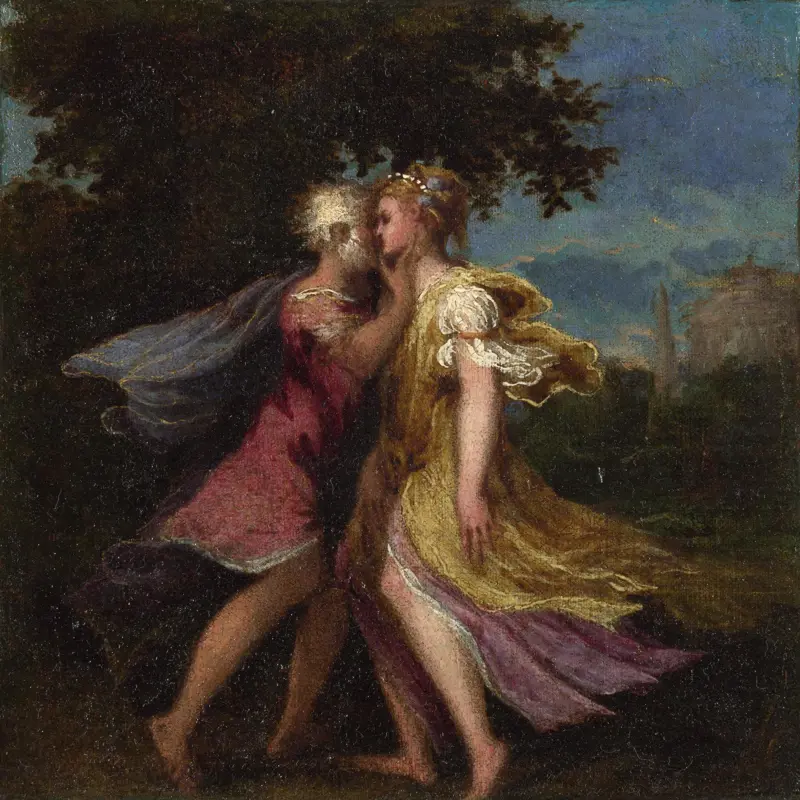Andrea Schiavone, 'Jupiter seducing Callisto', about 1550
About the work
Overview
While resting in a leafy grove, the nymph Callisto believed she heard the goddess Diana greet her. But it was Jupiter disguised as Diana. Here Callisto seems to realise her mistake. As Jupiter caresses Callisto’s cheek, she places her right hand protectively on her thigh. Her knees bend in a curtsy or a faint and she appears shocked.
The brushstrokes in the fluttering draperies, which look almost like they’re drawn in chalk or pastels, lend a soft decorative beauty to this otherwise disturbing scene. This little painting originally decorated the end of a wooden chest. In the central panel Callisto’s fellow nymphs reveal her pregnancy to Diana (Musée de Picardie, Amiens). Arcas Hunting, for the other end of the chest, tells the final part of the story.
Key facts
Details
- Full title
- Jupiter seducing Callisto
- Artist
- Andrea Schiavone
- Artist dates
- Active about 1530, died 1564
- Part of the series
- Two Mythological Scenes
- Date made
- About 1550
- Medium and support
- Oil on canvas
- Dimensions
- 18.7 × 18.9 cm
- Acquisition credit
- Bought, 1860
- Inventory number
- NG1884
- Location
- Not on display
- Collection
- Main Collection
- Frame
- 20th-century Replica Frame
Provenance
Additional information
Text extracted from the ‘Provenance’ section of the catalogue entry in Nicholas Penny, ‘National Gallery Catalogues: The Sixteenth Century Italian Paintings’, vol. 2, ‘Venice 1540–1600’, London 2008; for further information, see the full catalogue entry.
Exhibition history
-
2009Titian, Tintoretto, Veronese: Rivals in Renaissance VeniceMusée du Louvre17 September 2009 - 4 January 2010
-
2015Splendors of the Renaissance in Venice: Andrea Schiavone among Parmigianino, Tintoretto and TitianMuseo Correr28 November 2015 - 10 April 2016
Bibliography
-
1959Gould, Cecil, National Gallery Catalogues: The Sixteenth Century Venetian School, London 1959
-
1987Gould, Cecil, National Gallery Catalogues: The Sixteenth Century Italian Schools, London 1987
-
2001
C. Baker and T. Henry, The National Gallery: Complete Illustrated Catalogue, London 2001
-
2008Penny, Nicholas, National Gallery Catalogues: The Sixteenth Century Italian Paintings, 2, Venice, 1540-1600, London 2008
Frame
Made in England in 1997, this frame is crafted from walnut wood with gilt accents, an effect known as ‘lumeggiato in oro’. It is modelled on an Italian Renaissance moulding. The frame features straight gadroons along the outer reverse moulding and round flutes on the inner hollow. The corners are embellished with acanthus leaves. The flat frieze has a double bead-and-reel motif along the sight edge.
Schiavone’s small painting Jupiter seducing Callisto once adorned the end of a wooden cassone, or chest. The new frame was designed to evoke the style of the original sixteenth-century furniture, which was often made from walnut and adorned with golden highlights.
About this record
If you know more about this work or have spotted an error, please contact us. Please note that exhibition histories are listed from 2009 onwards. Bibliographies may not be complete; more comprehensive information is available in the National Gallery Library.
Images
About the series: Two Mythological Scenes

Overview
These are two of three paintings made to decorate the front and sides of a wooden chest, known in Italian as a cassone. They depict the story of the nymph Callisto, as told in Ovid’s Metamorphoses. Such chests were important pieces of furniture used for storing clothes and household linen. A bride would be given one by her parents as a wedding gift and she would take it with her to her marital home.
Jupiter seducing Callisto is the first episode depicted. While Callisto was resting in a leafy glade, Jupiter appeared disguised as Diana, goddess of chastity. He seduced Callisto and made her pregnant. In the long painting for the front of the cassone (Musée de Picardie, Amiens) Callisto’s fellow nymphs reveal her pregnancy to Diana. When Diana discovered that Callisto was pregnant, she turned her into a bear. In the third episode of the story the bear is shot dead by Callisto’s son Arcas, who does not realise that it is his mother.


